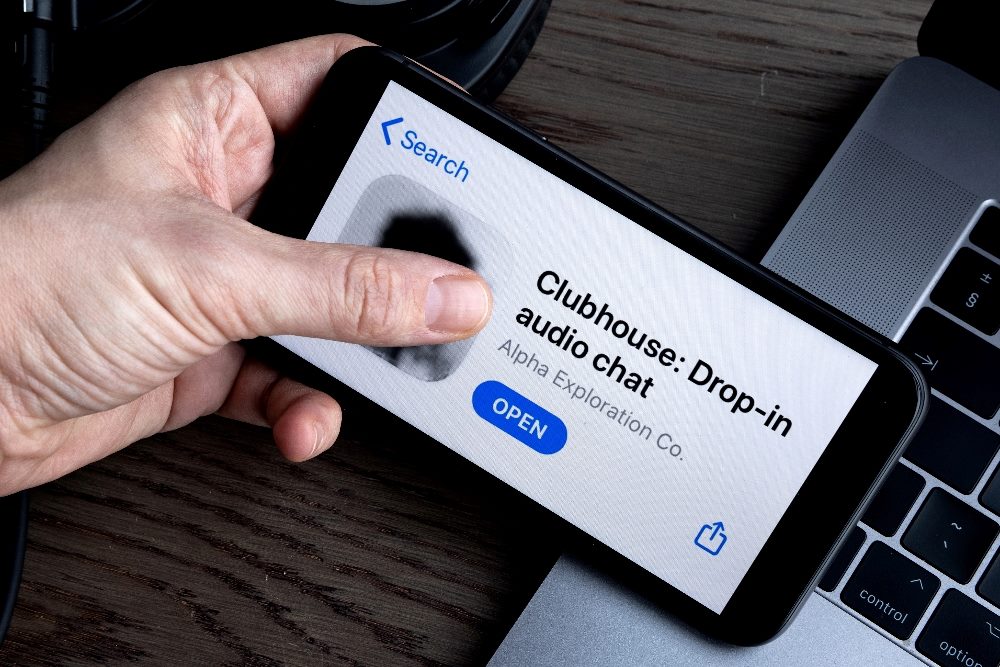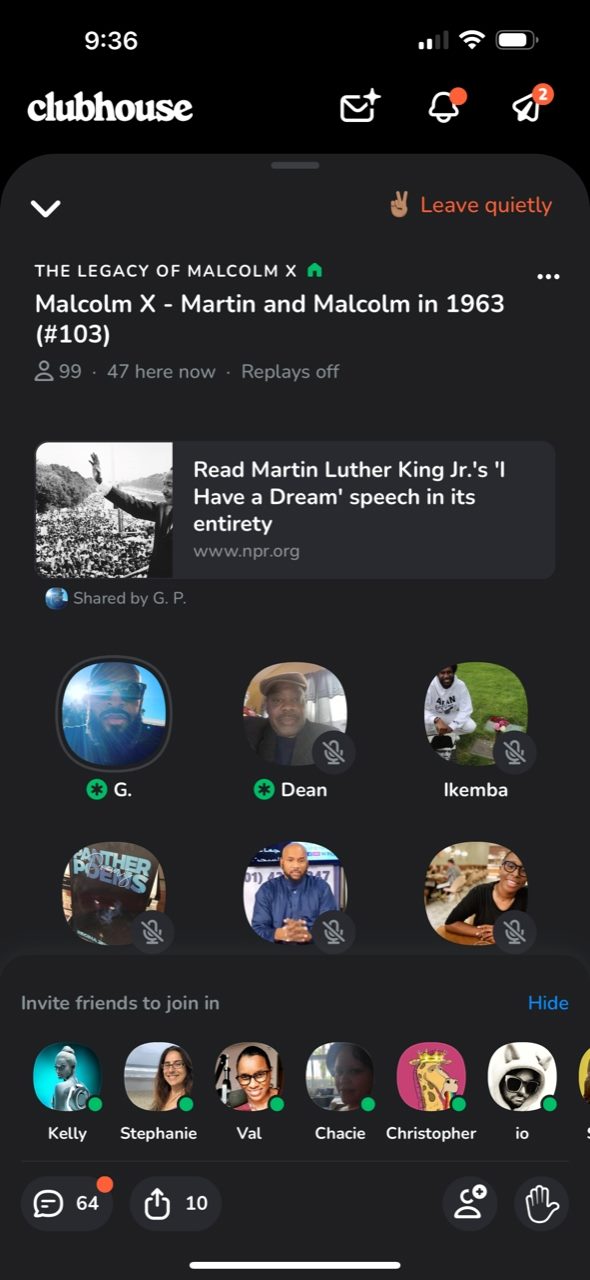The Gist
- Clubhouse Social media rebranding. Clubhouse's new Chat feature introduces asynchronous communication, reshaping interactions for both users and marketers.
- Quick adaptation. Rapid, unannounced alterations in the Clubhouse app have left users and marketers revising strategies swiftly.
- Connection priority. Clubhouse shifts its emphasis from reach metrics to fostering meaningful relationships, triggering a reevaluation in social media marketing strategies.
Clubhouse, known for its real-time audio conversations, is evolving. The social audio app has rolled out a new feature called "Chats," offering a different approach to interaction. With Chats, users can record messages and share them with their circle. The functionality doesn't stop there; people can also attach reply messages to the original recording. This forms a threaded series of audio clips that revolve around a particular topic, adding a new layer of engagement on the platform. Let’s take a closer look at the Clubhouse social media rebranding.

The updated app responds to a challenge all social media platforms face: adapting to changing user preferences and evolving market dynamics. Significant shifts like Clubhouse's social media rebranding and its new feature should prompt marketers to reevaluate how such changes impact their customer experience strategies.
Clubhouse Social Media Rebranding: What Is Chats?
Before its latest Clubhouse social media rebranding, the platform featured "rooms," which were app screens displaying user profiles where real-time conversations occurred. These rooms included a side panel for text comments during discussions, creating dual channels of communication. At times, text participants were invited to join the stage. Room hosts and their selected moderators were responsible for managing the dialogue, which could be hit or miss in terms of fostering productive or positive conversations. Occasionally, discussions devolved into arguments and harassment.

Chats Are Now a Room Category
Following the Clubhouse social media rebranding, chats are now a category of room, while the original rooms have been renamed "Live Chats." The Chats feature allows Clubhouse users to record a short message for others to hear and reply to. A timer on the record button gives users 30 seconds to speak.

Chats Complement Live Chat
Chats can complement a Live Chat. A Chat host can also include a website link related to the topic they are discussing, making it similar to a Live Chat in that aspect. Text commenting has been removed from Live Chat rooms, so Chats effectively take over the role that text messages once played.
Asynchronous Participation
Chats introduce asynchronous participation, offering a conversational experience akin to threaded posts on Twitter, Instagram or Threads. Users can pause playback and toggle between shared messages by tapping the left and right sides of the screen. Chat rooms can be shared online through a link, and users can subscribe to a Chat to receive notifications of new comments.
On Stage and Fully Engaged
Chats offer Clubhouse users a more accessible way to participate compared to waiting to join a live room discussion. While Live Chats are still more convenient than physical gatherings, they require participants on stage to be fully engaged. The Chats feature broadens participation on a topic and allows users to respond at a pace that better suits their real-world activities.
Related Article: Wondering About the Invite-Only Clubhouse App? Here Is What All the Fuss Is About
App Update Reflects the Renewed Direction
The app interface has been updated to integrate Chats and reorganize supporting features, underscoring Clubhouse's new social media rebranding direction. The most notable change is in the hallway, the app section where users view room topics and choose a room to join. The hallway now displays a mix of Live Chats and Chats. A prominent microphone button has been positioned at the bottom center of the screen to encourage users to either leave a Chat or participate in a Live Chat.

The Houses Feature
The "Houses" feature, introduced a year ago to allow users to host multiple rooms, remains but in a slightly reduced role. The icon to search for Houses within the app has been removed and replaced by a speech bubble icon.
Related Article: Play It Again, Sam: Use Clubhouse Replays to Improve Your Social Media Strategies
What These Changes Mean for A Marketing Strategy on Clubhouse?
Clubhouse's brief history is shaped by the pandemic era and the current state of social media, thus the need for a social media rebranding. Launched in 2020, the app quickly drew people seeking connection during the pandemic. Since then, usage metrics have experienced some decline.
A Revamped Business Model
Chats mark not only the first major new rebranding feature for Clubhouse since layoffs generated industry buzz, but it also signifies a revamped business model. The app's changes aim to foster closer relationships and connections among users, moving away from a sole focus on gaining followers. Co-founder and CEO Paul Davison said in the app's weekly townhall that "What people love about Clubhouse is the people," emphasizing that the goal isn't "maximizing reach to faceless people." Even the homepage of the Clubhouse website features a tagline, "Friends Over Followers," to underscore the platform's original mission and future direction.
Related Article: Why 'X'? What Lessons Does Twitter Rebranding Hold for Marketers?
Where Does The Clubhouse Rebranding Fit In Social Media?
Initially, Clubhouse illustrates how rebranding a social media platform can affect a marketer's acquisition strategy. Strategies ranging from digital ads to influencer campaigns often depend on these platforms as online referral sources to support a variety of conversion goals, from app downloads to audience engagement. However, if the platform starts attracting a different audience than what marketers initially targeted, they must reassess whether their brands should continue to be featured there. A prominent example of this dynamic is Elon Musk's acquisition of Twitter, which has implications for the marketing landscape.
Shift in Analytics Attitude
Clubhouse signifies the most substantial rebranding to date among social media platforms. Its strategy mirrors a shift in analytics attitudes, focusing on meaningful connections over sheer reach metrics. For instance, the count of room attendees has been removed from the app to encourage users to treat rooms more like casual gatherings than platforms for grandstanding. While many found the counts useful for branding and community-building, some exploited them to justify pitching poorly conceived services. This move to eliminate counts is akin to YouTube's decision to remove the dislike count last year.
Shifting User Behavior
The change coincides with a broader shift in user behavior on social media platforms that led to the social media rebranding. Insider Intelligence has reported that people are spending more time on platforms but posting less frequently, leading to feeds cluttered with influencer marketing and automated commentary. While this environment may capture attention, it is less likely to foster the same level of engagement as in previous years.
All of this means marketers must be ready to alter their traditional strategy to court social media users.
Related Article: Learning From SurveyMonkey’s Rebranding Strategy U-Turn
Changing Customer Experience Too Swiftly
Clubhouse rolled out the changes quickly, giving users little advance notice. The most startling element was that the update severed connections with people who appeared to engage less frequently with a profile. For instance, I initially had 1,200 followers on my Clubhouse profile; the update cut that number in half, removing many people I had recently connected with. I had to manually search and reconnect with those removed followers. This experience was not unique to me; many app users faced similar changes, with those using the platform for business purposes expressing the most concern. If you had a large following, those followers were likely genuine fans rather than trolls, as many people use Clubhouse in the same way they would listen to a favorite podcast.
Quick Changes Leave Some Users Feeling Alienated
The Clubhouse social media rebranding changes left many long-time users feeling alienated, a risky sentiment given that Chats was Clubhouse's first major product announcement since laying off half its staff. During a recent large chat gathering, one user noted that Clubhouse might have unintentionally triggered personal crises for those who rely on the platform for remote mental health support.
Related Article: Elon Musk Transforms Twitter: Farewell Blue Bird — Hello X
The Pressure to Get the User Experience Right Off the Bat
There are also UX details that could have made the app updates more intuitive. For example, Chats lack on-screen directional buttons, making it initially unclear that users can navigate back and forth among the recorded replies.
Chats & Live Chats
Additionally, some users believe that Live Chats and Chats should be more clearly distinguished. The hallway doesn't offer a significant visual difference between the two, except for a bleeping dot next to the Live Chat listings.
Need for More Explicit Explaining
Social media platforms should be more explicit in explaining features that impact user experience, rather than letting users "discover" how these features operate. Going forward, platforms will face increasing pressure to not only roll out updates, but also to make features more intuitive and less subject to the whims of algorithms and developers.
Marketers Must See Trends As Opportunity to Alter Social Media Strategy
However, the update also opens the door for users to get creative in their communication. Despite initial reactions, users have innovatively gamified Chat discussions in various ways, like mimicking voicemail messages or asking people to share favorite memories or personal preferences, such as favorite ice creams. Others have used Chats to disseminate information, such as compatibility issues with iPhones that upgraded to iOS 17.
Cultivating Audience Relationships
Marketers utilizing Clubhouse Chats can cultivate audience relationships by offering tips and tricks related to their products or services, shaping the Chats into a shareable series. This enables people to engage with and learn more about the business. However, this strategy comes with caveats. Clubhouse is increasingly targeting personal relationships, aiming to become the go-to audio hangout for the emerging social media landscape. While still business-friendly, marketers will need to determine whether the audience cultivated through such a casual platform aligns with their overall brand.
Final Thought on the Clubhouse Social Media Rebranding
Clubhouse introduced a new challenge with the Chat feature but at the same time it gave people something to talk about.
